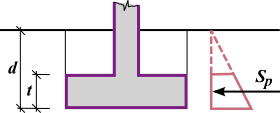Horizontal Bearing Capacity of Foundation
The foundation horizontal bearing capacity is verified according to the theory of limit states using the following inequality:
![]()
or based on the factor of safety as:
![]()
where:
![]()
![]()
where: | ψd | - | angle of friction between the foundation and soil |
ad | - | cohesion between the foundation and soil | |
Aef | - | effective area of the foundation | |
Spd | - | earth resistance | |
Hx,Hy | - | components of the horizontal force | |
Q | - | extreme design vertical force | |
γRH | - | coefficient of the horizontal bearing capacity of the foundation (for input use the "Spread Footing" tab) | |
SF | - | safety factor |
When adopting the analysis methodology according to EN 1997 the term with friction between foundation and soil (Q*tanψd) is excluded for undrained conditions.
When calculating bearing capacity according to CSN 73 1004 and assessment according to EN1997 - DA1, the horizontal bearing capacity is automatically reduced by 1.5.
The analysis depends on the design angle of internal friction below the footing bottom φd, the design value of cohesion below the footing bottom cd and the design value of earth resistance Spd. If the soil-footing frictional angle and the soil-footing cohesion are less than the values of soil below the footing bottom, then it is necessary to use those values.
The earth resistance is assumed as displayed in the figure:
 Earth resistance
Earth resistance
The earth resistance Spd is found with the help of the reduction of passive earth pressure or pressure at rest employing influence coefficients:
![]()
where: | Sp | - | passive earth pressure, pressure at rest or reduced passive pressure |
γmR | - | coefficient of reduction of earth resistance (for input used the "Spread Footing" tab) - for the analysis according to CSN 73 1002 it assumes the value γmR = 1.5 for passive pressure, γmR = 1.3 for pressure at rest |
Coefficients of earth pressures are clear from the following formulas:
for passive pressure:
![]()
for pressure at rest in drained soils:
![]()
for pressure at rest in other soils:
![]()
When determining the reduced passive pressure, the resultant force includes contributions due to the passive pressure and pressure at rest.
The passive pressure can be considered, if the deformation needed for its activation does not cause unallowable stresses or deformations in the upper structure.